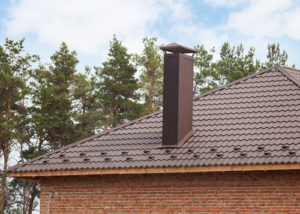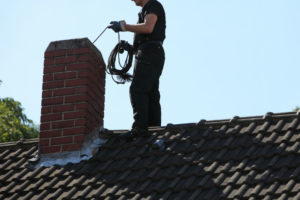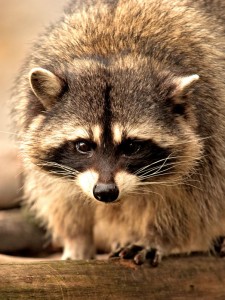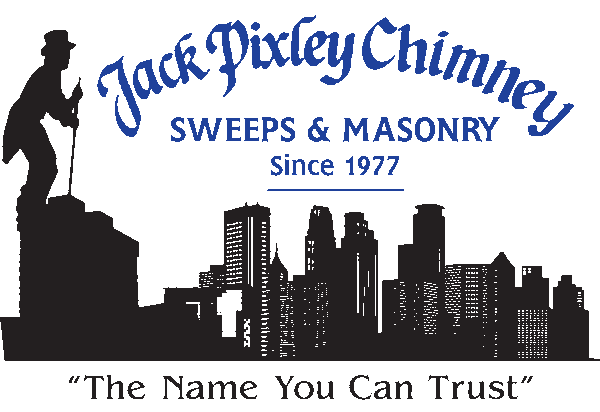While all parts of the chimney serve a specific purpose, few are as important as the chimney cap. A quality chimney cap can protect your entire fireplace system and keep it in good condition for years to come.
What is a chimney cap?
A chimney cap is a fitted metal hood that sits on top of the chimney structure and protects the top of the flue. Chimney caps have a solid top and mesh or wire sides. The solid top protects the chimney from moisture, animals, and debris while the open sides allow smoke and gas to safely vent.
Three ways a chimney cap protects your home
The following are three of the ways installing a chimney cap can protect your fireplace system.
1. Keep animals out
Raccoons, squirrels, birds, and other animals view chimneys as a safe, dark, enclosed and protected place to hide from predators and build nests. Unfortunately, animal entry can cause serious damage to your fireplace and chimney.
Animals damage the chimney and fireplace in a number of ways. First, they can scratch interior fireplace components such as the chimney liner. If your chimney has a clay tile liner, it may be necessary to reline the entire flue. Animal entry also increases the risk of chimney fire; nesting materials, food, and droppings can become dry in the flue and accidentally ignite from a stray spark or ember. The presence of animals in the chimney can also expose your family to diseases and pests such as lice or maggots – as well as the smells associated with a trapped animal.
2. Reduce risk of accidental fire
While fireplace safety and chimney maintenance significantly reduces the risk of chimney fire, chimney caps are an additional level of protection against accidental fires. First, the solid metal top and mesh sides act as spark catchers; it prevents embers, sparks, and hot coals from landing on the roof. Chimney caps also reduce the risk of fire by keeping debris out of the chimney. This keeps them from accumulating in the flue and drying out or catching fire.
Water from rain, sleet, snow, ice, and even sprinklers and hoses can be extremely damaging to your chimney. While fireplace and chimney components are designed to withstand extreme heat, even small amounts of moisture can cause significant damage.
Whether it is from a few droplets of a serious leak, water wreaks havoc throughout the chimney. Moisture can cause cracks in clay tile chimney liners, rust dampers, and even damage surrounding insulation, ceilings, and building materials. The combination of water along with the dark, moist chimney can also lead to mold and mildew growth.
Have your chimney cap inspected today!
A quality, well fitting chimney cap is an important part of protecting your entire chimney system. Contact the experts at Jack Pixley Sweeps to schedule your next chimney cap inspection. Our expert staff of CSIA certified chimney sweeps can ensure your chimney cap is in good condition, recommend necessary repairs, or even help you find a new chimney cap for your fireplace system.
 While the fall burning season may have just started, it’s never too early to start thinking about spring. If you haven’t had your chimney swept or inspected this season, now may be the best time to have it done; however, now is also an excellent time to have new chimney caps installed. Not only will they protect your chimney this winter, but they can keep animals out when spring arrives.
While the fall burning season may have just started, it’s never too early to start thinking about spring. If you haven’t had your chimney swept or inspected this season, now may be the best time to have it done; however, now is also an excellent time to have new chimney caps installed. Not only will they protect your chimney this winter, but they can keep animals out when spring arrives.
The importance of preventative maintenance
Fireplaces and chimneys are built to last, but they need regular cleanings and inspections in order to burn safely and efficiently. By having regular preventative maintenance performed, you can ensure your fireplace will burn safely for years to come.
One of the most common – and most important – parts of fireplace maintenance is an annual chimney sweeping. The Chimney Safety Institute of America recommends that all homes should have their chimneys swept at least once per year, regardless of how often you use your fireplace. Regular chimney sweepings remove creosote, a highly flammable byproduct of fuel burning fires that accumulates in the chimney over time. Likewise, regular sweepings ensure there are no other blockages in the chimney that prevent proper drafting or create a fire hazard.
Chimney inspections are another important part of fireplace maintenance. An inspection can help identify minor areas of damage before they turn into more serious deterioration. This is especially important for areas of the chimney that are not easily accessible or cannot be seen from street level. Chimney caps are one fireplace component that benefit from being inspected, as their damage may otherwise go unnoticed.
Chimney caps protect your fireplace system year round!
Chimney caps, sometimes known as spark arrestors or rain guards, are an important part of your chimney system; sitting at the top of the chimney, these caps have metal tops and mesh or wires sides that keep animals, debris, and moisture out while letting smoke safely draft. During the busy burning season, chimney caps protect your fireplace by keeping rain, sleet, and snow out, as well as keeping sparks from flying onto the roof or nearby bushes and trees. This protects your home – and your neighbors – from roof fires when the fireplace is in use.
Chimney caps continue to protect your home into the spring. Raccoons are especially fond of nesting in chimneys during the early spring; often taking up residence on the fireplace’s smoke shelf, they can be difficult to remove and can cause damage to your chimney system. A well installed, sturdy chimney cap cannot be pulled up by handy paws and keeps raccoons and other animals out.
Maintaining your fireplace and chimney is a year round job; make sure your system is ready for next spring by having your chimney cap inspected. If you need a new chimney cap, trust the experts at Jack Pixley Sweeps to install a cap that will keep raccoons – along with moisture and debris – out of your chimney. Contact us today to learn more about this preventative chimney maintenance.
Whether it’s flapping, scratching, climbing, or babies calling for their mother, hearing the sounds of animals inside your chimney can be an unsettling experience. Because they are safely protected from the elements, chimneys present an ideal hiding place or nesting ground for many birds and small mammals, especially in the spring time.

Unfortunately, the presence of animals in your chimney is dangerous for the animals and harmful to your family’s health and safety. Because of this, we recommend calling a chimney sweep or animal removal company as soon as you hear a noise in your chimney.
How do animals get into my chimney?
Animals, especially those seeking shelter from rain, cold temperatures, or predators, are extremely adept at finding their way into chimney structures. The primary way most animals get into your chimney structure is through a damaged or missing chimney cap. Some animals, like raccoons, will even claw or bite damaged portions of the chimney cap until they create a large enough hole for their entry.
A chimney cap protects the top of your chimney from not only animal entry, but also from moisture or other debris from getting into the flue. A top sealing damper works in the same way as a chimney cap as long as it is closed whenever the chimney is not in use.
What are the dangers of animals in my chimney?
If the top of the flue is unprotected, animals can easily enter the chimney structure to nest or seek shelter. Unfortunately, many animals cannot get out once they get in. Being in the dark of the narrow flue can be extremely disorienting, causing them to scratch – and therefore damage – the flue liner. In addition, nesting materials or animal droppings can create both strong odors and fire hazards. This debris may partially block the flue, prevent smoke and gas from properly exiting the chimney, or ignite when dried from stray sparks or embers.
Why should I have animals professionally removed?
Some intrepid homeowners may attempt to remove animals from their chimneys themselves. Unfortunately, this can be dangerous for you, your home, and the animals. First, homeowners should never attempt to “smoke out” animals in their chimneys, as the heat and gas from the fire will kill animals before they are able to exit the chimney. In addition, opening the damper to force animals into the firebox only serves as a way to expose you and your family to diseases carried by wild animals – or get a bird, raccoon, or squirrel trapped in your home.
When animals are alive and trapped in the chimney, removing a small portion of the masonry may be necessary to get them out. In order to prevent serious structural damage to the chimney structure, this should only be done by a professional. At Jack Pixley Sweeps, we have perfected a method of animal removal that only requires the removal of four bricks; once the animals are gone, we can easily repair the chimney damage and find ways to prevent the animals from coming back.
Contact Jack Pixley Sweeps at the first signs of animal entry to minimize damage to your chimney system!


 While the fall burning season may have just started, it’s never too early to start thinking about spring. If you haven’t had your chimney swept or inspected this season, now may be the best time to have it done; however, now is also an excellent time to have new chimney caps installed. Not only will they protect your chimney this winter, but they can keep animals out when spring arrives.
While the fall burning season may have just started, it’s never too early to start thinking about spring. If you haven’t had your chimney swept or inspected this season, now may be the best time to have it done; however, now is also an excellent time to have new chimney caps installed. Not only will they protect your chimney this winter, but they can keep animals out when spring arrives.